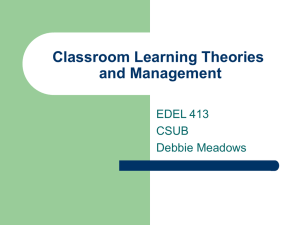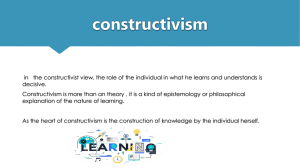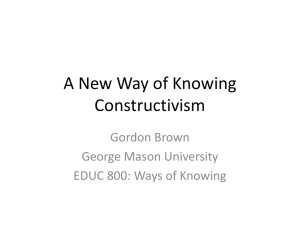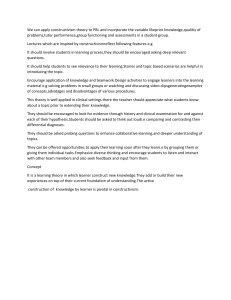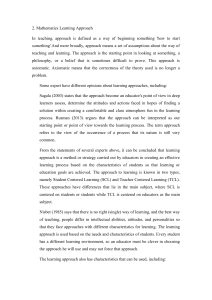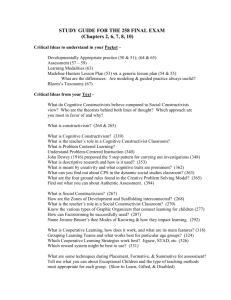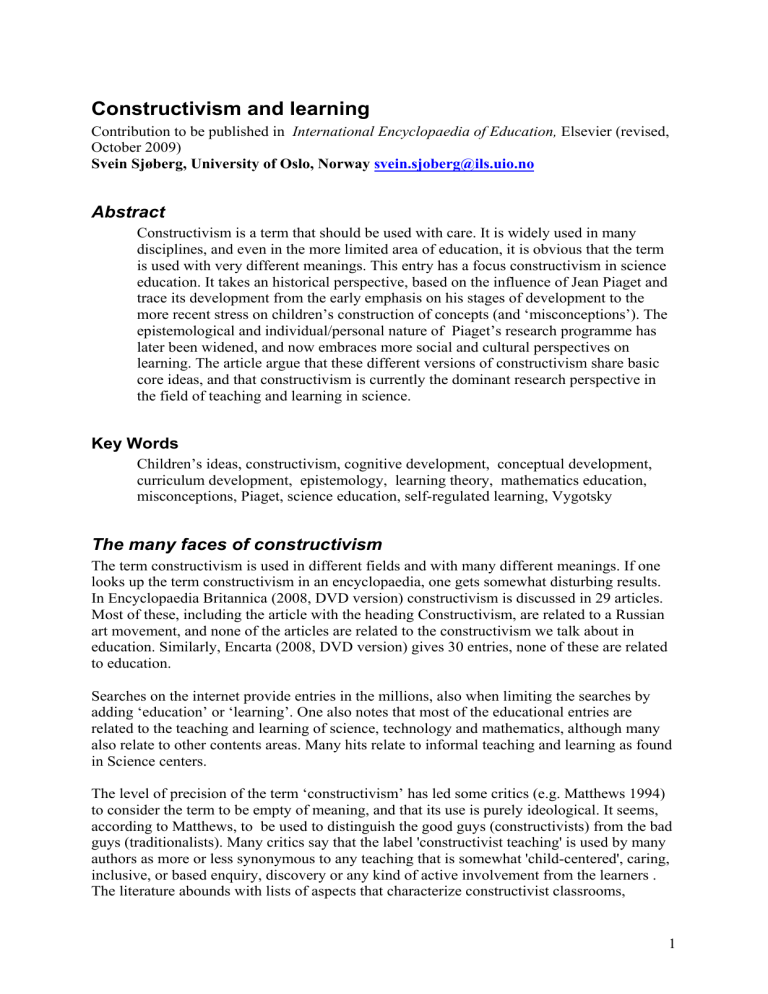
Constructivism and learning Contribution to be published in International Encyclopaedia of Education, Elsevier (revised, October 2009) Svein Sjøberg, University of Oslo, Norway svein.sjoberg@ils.uio.no Abstract Constructivism is a term that should be used with care. It is widely used in many disciplines, and even in the more limited area of education, it is obvious that the term is used with very different meanings. This entry has a focus constructivism in science education. It takes an historical perspective, based on the influence of Jean Piaget and trace its development from the early emphasis on his stages of development to the more recent stress on children’s construction of concepts (and ‘misconceptions’). The epistemological and individual/personal nature of Piaget’s research programme has later been widened, and now embraces more social and cultural perspectives on learning. The article argue that these different versions of constructivism share basic core ideas, and that constructivism is currently the dominant research perspective in the field of teaching and learning in science. Key Words Children’s ideas, constructivism, cognitive development, conceptual development, curriculum development, epistemology, learning theory, mathematics education, misconceptions, Piaget, science education, self-regulated learning, Vygotsky The many faces of constructivism The term constructivism is used in different fields and with many different meanings. If one looks up the term constructivism in an encyclopaedia, one gets somewhat disturbing results. In Encyclopaedia Britannica (2008, DVD version) constructivism is discussed in 29 articles. Most of these, including the article with the heading Constructivism, are related to a Russian art movement, and none of the articles are related to the constructivism we talk about in education. Similarly, Encarta (2008, DVD version) gives 30 entries, none of these are related to education. Searches on the internet provide entries in the millions, also when limiting the searches by adding ‘education’ or ‘learning’. One also notes that most of the educational entries are related to the teaching and learning of science, technology and mathematics, although many also relate to other contents areas. Many hits relate to informal teaching and learning as found in Science centers. The level of precision of the term ‘constructivism’ has led some critics (e.g. Matthews 1994) to consider the term to be empty of meaning, and that its use is purely ideological. It seems, according to Matthews, to be used to distinguish the good guys (constructivists) from the bad guys (traditionalists). Many critics say that the label 'constructivist teaching' is used by many authors as more or less synonymous to any teaching that is somewhat 'child-centered', caring, inclusive, or based enquiry, discovery or any kind of active involvement from the learners . The literature abounds with lists of aspects that characterize constructivist classrooms, 1 constructivist teachers, constructivist curricula and constructivist assessment. Most of these articles and books have a low precision on the definition of the term, but they all seem to associate the term with something unquestionably positive. Based on such observations, many critics argue that constructivism as a meaningful concept has lost its power. Some call constructivism a new orthodoxy, a fad and a fashion, a movement (Erickson 2001) or even a religion with different sects (Phillips 1995). But there is, of course, also serious theoretical writing and research that strongly oppose such characterizations. Many academics claim that there is a strong theoretical underpinning of constructivism. But they also disagree with one another about the epistemological and theoretical status of constructivism. One should also note that even within the field of education, there are there are several varieties over the theme of constructivism. Many scholars use qualifiers when they refer to constructivism. Hence, we find individual and cognitive constructivism (often with reference to Jean Piaget), social constructivism (often with reference to Lev Vygotsky). Some use the term simple, mild or even naïve constructivism with reference mainly to some interpretations of Piaget, and with a contrast to radical constructivism, used by Ernst von Glasersfeld (e.g. 1984). Other widely used versions include contextual constructivism (Cobern 1993), sociotransformative constructivism (Rodriguez 1998 ), sociocultural constructivism (Tobin 1998). The list can be made longer, and many of the above qualifiers are used in new and inventive combinations. It is beyond the scope of this article to go in detail on differences and similarities behind this flourishing terminology. The point is simply to warn the reader about the possibility for misunderstandings, as well as for real and false disagreements. Constructivism: The construction of what? In this article, we are concerned with constructivism as a theory of learning. Hence, we are interested in how people construct meaning and knowledge. It is important to distinguish this from epistemology of scientific knowledge, i.e. the growth, development and status of scientific knowledge about the world. We may ask: What is constructed? 1. Is it our individual knowledge about the world? ("Children construct their own knowledge.") 2. Is it the shared and accepted scientific knowledge about the world as it exists in established science? ("Scientific knowledge is socially constructed") 3. Or is it the world itself? ("The world is socially constructed") The first of these questions is a problem of psychology and educational or learning theory, while the latter two are part of philosophy and epistemology. Question no 2 is also addressed by the sociology of knowledge and sociology of science. Analytically, it is important to keep these questions apart. One may, for instance, be a strong supporter of constructivist learning theories, while at the same time reject the two other stances, in particular the last and most extreme one. This latter kind of constructivism is criticized for being a subjectivist and relativist post-modern attack on the rationality of science (Boghossian 2006), a stance that certainly runs against any suggestions from for instance Piaget and Vygotsky to be discussed later in this article. 2 Much confusion and disagreement occur because one does not keep the fundamental differences between the nature of these 'constructivist' claims in mind. A recent book title is called Teaching Constructivist Science (Bentley, Ebert & Ebert 2007). While the book is about constructivist methods of teaching, the title may suggest that the authors claim that science itself is constructed. Constructivism and learning – core ideas Within the large family of constructivist learning theorists, there are some ideas that more or less all subscribe to. Hence, they may be seen to be a mild version of constructivist claims. Here are some of these core ideas, partly based on the analysis of Taber (2006). 1. Knowledge is actively constructed by the learner, not passively received from the outside. Learning is something done by the learner, not something that is imposed on the learner. 2. Learners come to the learning situation (in science etc.) with existing ideas about many phenomena. Some of these ideas are ad hoc and unstable; others are more deeply rooted and well developed. 3. Learner has their own individual ideas about the world, but there are also many similarities and common patterns in their ideas. Some of these ideas are socially and culturally accepted and shared, and they are often part of the language, supported by metaphors etc. They also often function well as tools to understand many phenomena. 4. These ideas are often at odds with accepted scientific ideas, and some of them may be persistent and hard to change. 5. Knowledge is represented in the brain as conceptual structures, and it is possible to model and describe these in some detail. 6. Teaching has to take the learner's existing ideas seriously if they want to change or challenge these. 7. Although knowledge in one sense is personal and individual, the learners construct their knowledge through their interaction with the physical world, collaboratively in social settings and in a cultural and linguistic environment. (The relative stress on such factors account for the different 'versions' of constructivism earlier alluded to.) The many phases of constructivism in education: A brief history The following description is based on how these ideas have emerged, with emphasis on the field of science education. Piaget and constructivism Many of the core ideas of constructivism are indeed very old, but it may be fruitful to present an historical account based on the influence of the Swiss psychologist and epistemologist Jean Piaget (1896 – 1980). Few intellectual have been so widely used and misused, understood and misunderstood as Piaget. A main reason for this is that his research and his perspective do not fit well into the established boundaries of academic disciplines. A brief version of his life story exemplifies this: at the age of 21 he had a PhD in biology, and his specialty was how organisms adapted to their environment. He was also deeply interested in philosophy. For some years he worked with psychoanalysis with CG Jung, later with testing of intelligence in the behaviorist tradition of Stanford-Binet and Cyril Burt. Piaget was, simultaneously or in succession, professor in several fields: in psychology, in sociology, in the history of science, in genetic and experimental psychology. Moreover, he used mathematical logic and group theory to express his ideas. He even contributed to the 3 development of this field. Most of his examples of the intellectual development came from observations and clinical interviews with children when they manipulated physical, technical and chemical objects in experiments that were rather similar to traditional textbook examples (pendulum, balance etc.) Piaget's biological background and language, his use of examples from physics and technology as well as his wish to formulate general theories in a mathematical way may explain why Piagetian theory has a strong appeal to science and mathematics educators. Piaget had the greatest admiration for physics as discipline, and he considered physics to be the most mature and developed of all scientific fields. He also corresponded and met with Albert Einstein, who was fascinated with Piaget's ideas. As one can understand, Jean Piaget covered several academic disciplines. It is, however, a paradox that the field where he has had most influence is in education. He was not at all an educator, and he actually wrote very little on teaching and pedagogy. Piaget was academically active for more than half a century, and he wrote more than 50 books and several hundred articles. Although he remained faithful to his initial research agenda, his theories developed during this period. When one tries to understand (or to critique) Piaget's theories, one must know 'which Piaget' one has in mind. The early Piaget is very different from the older, and in many ways he was his own best critic. Some of his books were rather badly translated from his original in French to English -- and then translated from English to other languages. Such factors may also have added to the confusion over his ideas. One might say that Piaget's strong interdisciplinary orientation was his strength, but it was also his problem, because it made his thinking difficult to access for people with a more typical (and narrow) academic background. However, Piaget's basic research problem remained the same all the time. His problem was epistemological and philosophical: What is the nature of knowledge? How does it grow and develop? Piaget's epistemological research agenda is well reflected in the name of the institution that he established in Geneva in 1955: "Centre international d'épistémologie génétique" (International center for genetic epistemology.) Here, of course, 'genetic' refers to the genesis and development of knowledge, and not to biological heredity. The nature of knowledge should, according to Piaget, be studied empirically where it actually is constructed and develops. This can be done either through the historical development of knowledge, as it is found in well established sciences (in particular physics and mathematics), or it may be studied in the growth and development of an individual. We may therefore say that Piaget's study of the development of children was in effect only to get empirical access to his epistemological research question: the growth of knowledge and the development of logical thinking. Piaget's earlier writings, from the 1920s on, were on children's conceptions of the world. This was, in fact, also the title of one of his earlier books (Piaget 1929). Already at that time, he started to use the term constructivism: A very influential book had the title "La construction du réel chez l'enfant" (The Construction of Reality in the Child). The French original came in 1937, with the Introduction written already in 1925. His other writings from the same period (late 1920s to 1940) included detailed studies on how children developed (or constructed) ideas about time, space, causality, logic, numbers, movement and velocity, conservation and a long list of various natural phenomena. 4 As we can see, Piaget gave meaning to the term constructivism long before it was used by academics in other fields, like the psychologist George Kelly's "Personal construct theory" (1955) and the sociologists Berger and Luckman in their "Social construction of reality" (1967). He remained faithful to this constructivist perspective throughout his long active period. In his last publication, written the year that he died, some 55 years after his first use of constructivism, he summarizes his life-long program: his task had been to - establish what we have called a constructivist theory of knowledge and, at the same time, refute the empiricist and nativist theories. The essential problem of a theory of knowledge is: How is new knowledge constructed? Is it, as empiricism contends, always derived from observing reality, or is it preformed in the human mind, and thus innate? Even our earlier work, I believe, clearly showed the insufficiencies of both the empiricist and preformist theories. (Piaget 1980, p3) In this statement, Piaget locates his own constructivist epistemology. He rejects the empiricist and behaviorist stance that knowledge derives directly from sense experiences. He also rejects the rationalist or preformist view that knowledge is innate and develops more or less biologically as we grow and mature. His whole life program consists of showing how both these views are insufficient. Piaget developed his theory of knowledge based on ideas derived from biology: like the process of adaptation, consisting of assimilation and accommodation. Other Piagetian concepts like self-regulation also indicate his basic belief that also the development of intelligence and thinking should be understood as the individual's biological adaptation to the external world. As noted, Piaget was not very interested in education, let alone in teaching (Solomon 1994). Nevertheless, his theories have probably been more widely used (and misused) in education than in other fields. As also noted, the main uses have been in science and mathematics education from reasons explained earlier. But even in these areas, his theories have been used in a wide and often contradictory way. Let us briefly look at this development. Piagetian constructivism emerges Piaget's theories were 'discovered' by science educators in the early 1970s. At that time, most attention was given to his stage theory. A recurring theme in Piaget's writing was the description of stages of intellectual development that each individual had to pass. Names like the psychomotor, the intuitive, the concrete operational and the formal operational stage soon became part of educational terminology. He asserted, for instance, that an individual at the concrete operational level was able to understand and perform certain logical operations, while the spectrum was much wider at the formal operational stage. At this stage, the individual could reason in a way that is close to ways commonly used in science, like thinking with hypotheses and abstract models, understanding proportionality and control of variables etc. These stages are described in Piaget's publications (e.g. Piaget & Inhelder 1958). On the basis of these descriptions, educators developed written test that they used to classify the learners by their Piagetian level. They also developed teaching material that was supposed to match the level of abstraction of the learner. This so-called 'matching model' became very influential for a long period. 5 Numerous studies based on the Piagetian stage theory were published in the journals for science and mathematics education, and large curriculum development projects were carried out. In the US, the SCIS-project (Science Curriculum Improvement Study) (SCIS 1974) was based on Piagetian stage theory. This program was also exported to several other countries, and had some success. It is still in use some places. The British Science 5/13-project had a similar foundation (Science 5/13 1972). Some of the strongest supporters of the stage theory claimed that this theory and its practical applications had turned science education into a real science. "Towards a science of science education" was the ambitious title of a book by two of the British pioneers in the field (Shayer & Adey 1981). This book presented experiences from a large research and development program based on Piagetian stage thinking. They also provided evidence that the development from one stage to the next could be accelerated or enhanced by certain learning experiences and tasks (Shayer & Adey 1992). But, although this theoretical stance and the corresponding curriculum projects gave inspiration and positive impetus to science education, the stress on Piagetian stage theory gradually lost supporters and waned in popularity. In short, the approach did not hold what it promised. The theoretical underpinning was also under attack. Most important, however, is probably new and more promising developments. The new turn in the thinking in science education may be exemplified by a seminal article written jointly by the American Jack Easley and his former PhD-student Rosalind Driver from the UK (Driver & Easley 1978). In hindsight, we may say that this article is a starting point for what we now label the constructivist tradition in science education. In their article, Driver and Easley reviewed research on children's ideas and perceptions regarding natural phenomena, and they also provided a language and a theoretical perspective to talk about the findings and their educational aspects. The article was strongly influenced by Piagetian theory, and it triggered a new interest for the actual contents side of children's ideas. While the Piagetian stage theory was centered around the more formal and logical aspects of children's thinking, we now got a new interest for what concrete ideas that children bring. They also anchored their interpretations to Piaget's constructivist epistemology as well as to his early studies of children's ideas. In the following years, the research agenda in science (and mathematics) education changed gradually. There was a growing concern about the ideas that children develop about the phenomena in the physical world (as well as other phenomena), and the term constructivism started to occur frequently. Rosalind Driver was a key person in the development of this constructivist movement. Alone, and in cooperation with colleagues from several other countries, she published academic articles (e.g. Driver & Oldham 1986) as well as books meant for the classroom teacher (e.g. Driver 1983). These (and similar) books are probably the main reason why the ideas behind constructivism soon became highly influential, not only in research, but also in teacher training and in science classrooms. Constructivism and children's ideas Although it had been known for a long time that pupils have their own ideas, often at odds with those of established science, about natural and other phenomena, the emergence of constructivism in the late 1970s and early 1980s triggered a virtual flood of such studies. Children's ideas for all thinkable phenomena (like force and movement, electricity, heat etc.) 6 were studied in great detail. This also implied a re-discovery of the early Piaget (from the late 1920s and some decades to follow), where he had published many books on these themes. Also Piaget's research methodology, the clinical interview, got a revival, but was also supplemented by many other research methods, qualitative as well as quantitative. The many names given to children's (and indeed adults') ideas reveal that different researchers understood and interpreted their findings from very different theoretical perspectives. The literature reported on children's ideas, their alternative paradigms, mini-theories, conceptions, misconceptions, etc. The variety in terminology reflects ambiguity and some confusion over the status of what one observed. This, of course, also has implications on how to act on such observations. If you face a 'misconception', you can simply try to correct the misunderstanding. If, on the other hand, the child's explanation has the character of being a paradigm, an alternative way of seeing the world, well integrated with other strongly held beliefs, then the educational task is indeed very different! However, the status of the ideas that children express may indeed differ from one type of phenomenon to another, and this is an empirical question that may be clarified by research. In some areas, one may find that the expressed ideas are very loose, often ad hoc, and even invented in the interview setting. Piaget himself wrote about these challenges in the 1920s. For other types of phenomena, children's explanations are more deeply rooted, well integrated, and systematically used to understand a wide class of experiences. In this case, they may be very resistant to change, and sometimes one should think twice before embarking on such a project. The research on children's ideas, often under the theoretical umbrella of 'constructivism' and/or 'conceptual change' proliferated from the early 1980's. Reinders Duit at IPN, the German Institute for Science Education in Kiel, maintains a bibliography that, according to the Introduction is "as an attempt to document constructivist research in science education.” The 2009-version contains 8400 research articles, a clear indication that this is by now a dominant perspective in science education research. Constructivism: Widening the perspective The influence from Piaget is evident in nearly all the written reference to constructivism, especially in the early phases. But Piaget's own perspective was, as noted, mostly on the general aspects of the development of knowledge per se. He was not so much interested in education, let alone teaching or conditions for good and effective learning. Constructivism has, as noted, developed from such a Piagetian perspective, and has drawn on other theorists who put more stress on social and cultural conditions for learning. This may explain why we now have so many varieties of constructivism. A main contributor to this development has been from a contemporary of Jean Piaget, the Russian Lev Vygotsky (1896-1934) and his students, mainly Luria and Leontiev. Vygotsky's work remained virtually unknown in the west until its "rediscovery" in the 1960s, when the translation of Thought and language from 1934 was published in English in 1962 (revised edition in 1986). It was not until the end of the 1970s that his works started to get attention, and his collected works were available in English only in the late 1990s. Many books have been written where Piaget and Vygotsky are seen as more or less opposites. It may be more productive to note some fundamental similarities. They may both clearly be seen as constructivists. Some of the differences between the two can be explained by the fact 7 that they had rather different research agendas. While Piaget was interested in epistemology and knowledge per se, Vygotsky was more interested in understanding the social and cultural conditions for human learning. Hence, his writings may be closer to the concerns of educators. With his stress on the social and collaborative nature of learning, Vygotsky is often considered to be the father of social constructivism, while Piaget is often classified as a father of personal (or cognitive) constructivism. It may be interesting to note that Piaget and Vygotsky corresponded, and that Piaget acknowledged to have been inspired by Vygotsky's ideas. Constructivism: Paradigm or research program? We have noted that constructivism is a dominant perspective in fields like science education. How profound is this influence? Some authors write about constructivism as a paradigm in a Kuhnian sense (Kuhn 1970). Others find it more proper to use the terminology of the philosopher Imre Lakatos (1970). They therefore argue that constructivism represent a socalled research program. For this author, the term paradigm in the Kuhnian sense seems to be too strong. A paradigm implies that the idea is so strong that it completely dominates and entire field or discipline, and that other ideas practically do not exist. (Like the paradigm of evolution in biology, or of atoms or quanta in physics). Therefore, the term research program seems more suitable. Lakatos (1970) has developed these ideas in details, but here are some basic ideas. A research program is a set of ideas that provide a platform of common assumptions and ideas about certain phenomena. This core of commitments are shared among those working in this research program. (Core ideas of constructivism have been suggested earlier in this article.) Several research programs may co-exist within the same field over time. A research program provides direction and structure of a field of research. It contains a 'positive heuristic' that may generate new knowledge and ideas for further research. When a research programs develops, grows and adds new knowledge, it may be called progressive. When it seizes to do so, it degenerates and may fade away, in particular if other research programs are seen to be more promising for new research. Many authors have used the concept of research programs on constructivism. Driver and Easley (1978) used the term in their seminal article in 1978. Joan Solomon wrote about the rise and fall of constructivism as a paradigm as well as a research program in 1994. In spite of this, the influence of constructivist ideas and studies continued to grow in the following years. Erickson revisited the theme and strengthened the claim of constructivism as a still progressive research program in 2001, and these ideas are supported used in a recent review article of the whole field of teaching and learning science (Taber 2006). The core set of ideas of constructivism suggested earlier in this article seem to be widely accepted, by many considered to be trivial. This is, in itself, a sign of their current dominance. But a set of principles for learning do not directly translate into a set of recommendations for good teaching. One cannot logically deduce a scientifically based pedagogy from a theory of learning. Many books claim to present constructivist teaching, often in the form of lists of concrete recommendations. Many authors also give detailed prescriptions regarding constructivist 8 curricula and constructivist assessments. It is beyond the scope of this article to enter into an analysis and critique of these widely differing recommendations, but simply to advice the reader to exercise some care regarding such assertions. Bibliography Bentley ML, Ebert SE & Ebert C (2007). Teaching Constructivist Science Thousands Oaks: SAGE Publications Berger, P. & Luckmann, T. (1967). The social construction of reality New York, NY. Doubleday. Boghossian P. (2006). Fear of Knowledge: Against Relativism and Constructivism, Oxford: Oxford University Press Cobern, W. (1993). Contextual constructivism in Tobin, K. (Ed) The Practice of constructivism in science education. . Washington DC. AAAS. p. 51-69 Driver, R. & Easley, J. (1978). Pupils and paradigms: A review of literature related to concept development in adolescent science students. Studies in Science Education, 5, 61-84. Driver, R. (1983). The Pupil as Scientist? Buckingham: Open University Press. Driver, R., & Oldham, V. (1986). A constructivist approach to curriculum development in science. Studies in Science Education, 13, 105-122 Driver, R., Asoko, H., Leach, J., Mortimer, EF., & Scott, P. (1994). Constructing scientific knowledge in the classroom. Educational Researcher, 23, (7), 5-12. Duit, R. & Treagust, D. (1998). Learning in science – from behaviourism towards social constructivism and beyond. In Fraser, B. & K. Tobin (eds.), International Handbook of Science Education. Dordrecht, Holland: Kluwer Academic Publishers Duit, R. (2009). Students' and Teachers' Conceptions and Science Education Database available at http://www.ipn.uni-kiel.de/aktuell/stcse/stcse.html Kiel: IPN Erickson G. (2001). Research programmes and the student science learning literature in Millar, R.; Leach, J.; Osborne, J. (eds.): Improving Science Education -- the contribution of research Buckingham: Open University Press Kelly, GA. (1955). The Psychology of Personal Constructs New York: W.W. Norton & Co Kuhn, TS. (1970). The Structure of Scientific Revolutions Chicago: Chicago University Press. Lakatos, I. (1970). Falsification and the Methodology of Scientific Research Programmes. In Lakatos I. & Musgrave A. (eds.) Criticism and the Growth of Knowledge London: Cambridge University Press Matthews, M. (1992). Constructivism and empiricism: An incomplete divorce. Research in Science Education, 22, 299-307. Matthews, M. (1994). Discontent with constructivism. Studies in Science Education, 24, 165172. Piaget, J (1929): The Child's Conception of the World. London: Paul Trench and Trubner Piaget, J. (1937). La construction du réel chez l'enfant, Paris: Delachaux et Niestlé, 1937. (In English, 1955: The Construction of Reality in the Child) Piaget, J (1980). Cahier de la foundation archives Jean Piaget, Genéve: CIEG Piaget, J & Inhelder, B (1958). The growth of logical thinking, from childhood to adolescence London: Routledge & Kegan Paul Piaget, J. (1983). Psychogenesis and the history of science (with Rolando Garcia), New York: Columbia University Press Rodriguez AJ (1998). Strategies for counterresistance: Toward sociotransformative constructivism and learning to teach science for diversity and for understanding John Wiley & Sons, Inc. J Res Sci Teach 35: 589-622 Science 5/13 (1972). With Objectives in Mind London: MacDonald Educational SCIS (1974). Teachers' Handbook Berkeley: Lawrence Hall of Science 9 Shayer, M. & Adey, P. (1981). Towards a Science of Science Teaching. Cognitive development and cognitive demand, London: Heinemann Educational Books Shayer, M. & Adey, P. (1992). Accelerating the development of formal thinking in middle and high school students 3: Testing the permanency of effects. Journal of Research in Science Teaching, 29, 1101-1115. Solomon, J. (1994). The Rise and Fall of Constructivism. Studies in Science Education, 23, 119. Taber, KS (2006). Beyond Constructivism: the Progressive Research Programme into Learning Science Studies in Science Education, 42, pp 125-184 Tobin, K. (1998). Sociocultural perspectives on the teaching and learning of Science. In M. Larochelle, N. Bednarz & J. Garrison (Eds.), Constructivism and education. Cambridge: Cambridge University Press Tobin, K. (Ed.) (1993). The practice of constructivism in science education. Washington DC: AAAS Press. von Glasersfeld E. (1984). An introduction to radical constructivism. In P. Watzlawick (ed.) The invented reality. London: W. W. Naughton & Co. Phillips, D. (1995). The good, the bad, and the ugly: The many faces of constructivism. Educational Researcher Vol. 24, no. 7, pp. 5-12 Further reading Fensham, P., Gunstone, R. & White, R.(eds.), (1994). The Content of Science: A Constructivist Approach to its Teaching and Learning. London: Falmer Press. Larochelle, M, Bednarz, N & Garrison J (Eds.), (1998). Constructivism and education. Cambridge: Cambridge University Press Matthews, M (ed.) (1998 ). Constructivism in Science Education. A Philosophical Examination London: Kluwer Academic Publishers Steffe L. & J. Gale J. (eds.) (1995). Constructivism in Education. Hillsdale, NJ: Lawrence Erlbaum. Svein Sjøberg (bio notes) Svein Sjøberg is professor in science education at Oslo University, Norway. He is educated as a nuclear physicist, later also in education. Has been involved in curriculum reforms and the writing of textbooks for all levels. Current research interests cover social, cultural and ethical aspects of science education, science education and development, gender and science education in developing countries. Critical approach to issues of scientific literacy and public understanding of science. He has held several appointments for national agencies and international organizations (EU, UNESCO, OECD) as well as positions in international academic associations. Member of the Advisory Group on the Science and Society action plan of the 6th Framework Programme of the EU FP6 (2002-06). Has received several national and international awards for his research and popularization and is invited member of The Norwegian Academy of Technological Sciences and The Norwegian Academy of Science and Letters. Organizer of the large-scale comparative project (40 countries) ROSE (The Relevance of Science Education on pupils' interests, attitudes, perceptions etc. of importance to science teaching and learning. Information and articles on http://folk.uio.no/sveinsj/ 10


